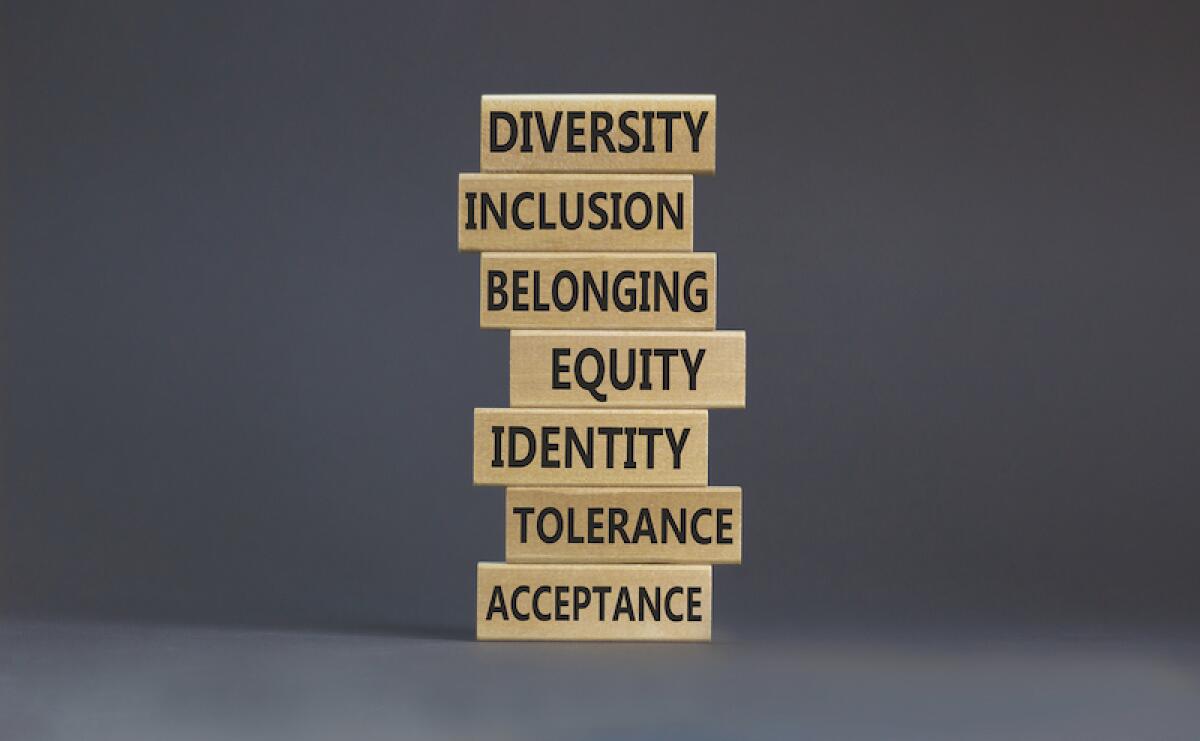Column: The N-word doesn’t belong in a fourth-grade classroom, even in poetry

- Share via
San Diego teacher Amy Glancy thought she’d prepared her fourth-grade students for the day’s language arts lesson. She knew there was a land mine in the poem she planned to read, but she considered it essential to what she was trying to teach.
The reading Glancy chose was Countee Cullen’s iconic Harlem Renaissance poem “Incident,” which poignantly renders a Black child’s painful encounter with racism, when a white boy calls him the N-word.
Glancy, who is white, said she wanted to “elevate the voices of Black poets” and chose this poem to support her school’s curricular focus on understanding U.S. history “from the nonwhite point of view.”
But her choice to read the actual slur aloud shocked and wounded some of her students and alarmed the school officials who heard their complaints.
Now Glancy, a veteran teacher new to the progressive High Tech Elementary School in Point Loma, has been pulled from her classroom while the incident is investigated. And she has landed in the midst of an ongoing national debate over how, why and whether the N-word should ever be uttered in classrooms.
The argument reflects the complexities of this moment in time where the N-word is a lightning rod.
Glancy said she cautioned the children before she read the poem, warning that some important parts might be uncomfortable to hear.
“Words are so powerful, and I want them to know that,” she explained to me.
Apparently that was something her 9- and 10-year-old students already knew — and they proceeded to school their teacher.
As soon as Glancy uttered the N-word, a student called out, “I can’t believe you did that!” and stormed out of class, followed by another angry student. Other students stayed but took their teacher to task.
“Ms. Glancy, you don’t understand how hard it is to hear that word,” one child told her, plaintively.
Two boys — one Black and one white — were particularly upset. They listened as the teacher explained her thinking, then they complained to the dean at lunchtime.
Glancy had expected “a big conversation” about the language in the poem, she said. But she did not anticipate the hostility of the fallout and was not equipped to address the hurt.
“I was very apologetic for making them feel that way,” she said.
When a student came to her after class and said “I can’t believe you said that word,” Glancy tried to blunt the pain: “I said, ‘I read the word’... It was [the poet’s] experience and his language, and it’s not my job to censor that.”
Which might be a perfectly logical response — if these were not such young children and Glancy was not a white teacher in a multiracial class, at a school that has as its mission promoting equity and inclusivity.
::
I didn’t expect to hear back when I reached out to Glancy on Twitter, where she describes herself as “passionate about teaching and learning and lighting the fire in others.”
But she called back right away, willing to walk me through all that happened that day — from the reading of the poem to the phone calls home to parents of every student in her class.
I tried to listen dispassionately. But I could see myself in every dimension of the story she told.
I was that 8-year-old in the poem, called “nigger” by white girls not much older than me, on a sleepover at the YMCA. It was supposed to be a fun community event for my sister and me. But even now, more than 50 years later, I remember how helpless and frightened we felt, in a room full of white people, with no one we could trust to protect us.
Decades later, I was that mother complaining to a middle-school teacher about subjecting Black kids to Mark Twain’s “nigger Jim,” over and over again. I knew that some kids in my daughter’s class snickered as they read “Huckleberry Finn,” while the lone Black boy in class sometimes seemed to be on the verge of tears. Did allegiance to the canon of American literature justify sacrificing his well-being?
And in between, I’d been the teacher in a college journalism class, confronted by a student who didn’t understand why she was not allowed to render an interview authentically. She’d been told to use “the N-word” in her story, even though the man she’d interviewed had said “nigger.” I responded to her question with the professorial version of “Because I say so” — because I was tired of explaining the heritage and hurt of the word to clueless white students.
I have never forgotten how hearing that word as a child made me feel like I was damaged goods. Or how angry I was when I realized that my own children were being uncomfortably spotlighted in class by the slur. Or how frustrating it was to accept that smart white students could make it to college with only the barest understanding of the epithet.
It would be easy now to opine that Glancy was thoughtless and shortsighted to rely on such an incendiary word as a teaching tool.
But I think it is more meaningful to ponder questions the incident raises, as debates over the word’s use are migrating from college campuses to elementary schools.
In cases such as Glancy’s, do we judge just the outcome or also the intent? If the teacher were Black, would this resonate differently? Is it appropriate, or even possible, to prepare young children to hear the slur as anything more than a taunt, in an era where the word has been weaponized?
The vile word is now a casual slur, wielded comfortably by witless bigots asserting white supremacy. But it’s also a term of endearment among some Black men and their young imitators; they have reclaimed the slur — amended colloquially to “nigga” — and don’t give a damn about establishment approval.
The N-word is evolving, as language does over time. And while there are all kinds of teaching guides, there is no consensus among experts about whether the word itself has value as a teaching tool.
There is something intrinsically ballistic about the word, no matter how many new iterations emerge.
Even researching and writing this column has been a peculiar emotional challenge for me. I get heart palpitations every time I type “nigger” in the search bar.
I wanted to understand that, so I called Harvard Law professor Randall Kennedy, whose 2002 book, “Nigger: The Strange Career of a Troublesome Word” examines the word’s endurance and the shifting boundaries on its use.
“Nigger is the baseline against which other potential slurs are measured,” he told me.
It has a centuries-long history of “wreaking havoc on American society” through its association with lynchings, mob violence and other atrocities committed against Black people, he said.
Its potency is measured by the way it has endured, even as other slurs have faded over time. The N-word “is still used to terrorize today … no matter how some people have tried to sanitize it,” Kennedy said.
He has used the word openly in his race-related university courses, he said, but only after the class has discussed it deeply.
Because context and preparation matter. Anyone who feels the need to say the word “ought to be aware of its baggage,” Kennedy says. It is “still a very menacing word.”
::
Menacing. That’s the term that sticks with me when I think about the feelings of the children in Glancy’s class.
She didn’t mean to alarm her students, but she also didn’t understand the sense of threat inherent in the slur — or the shock of the word coming from a teacher they trusted.
If Glancy were a Black teacher, I suspect this would have played out differently — or not occurred at all. Black teachers would likely have had their own N-word experiences to draw on, and might be more likely to consider whether the literary lesson would be worth the pain the word could spawn.
In hindsight, that is a question that should have been asked: Can we really expect a fourth-grader to be able to uncouple the shock of the slur from its value as a literary device?
Looking backward at that, Glancy said she realizes she made a mistake. “I’m trying to educate myself. I want to do better,” she told me, ticking off a list of resources she’s consulting.
“Where I struggle the most is that I’m pretty well educated and literate, and I read a lot of views that are different than mine. I seek out information, and still I had no clue,” she said. “That is what’s frightening to me.”
Now Glancy is broadening her sources, stockpiling advice, trying to find a way to make amends to her students — and fervently hoping she will be allowed to return to the classroom to put what she’s learned into practice.
I’m hoping for that, too. And here’s something I hope she has come to understand: Teaching is not just about academic dogma and lighting fires, but about looking past the limits of your own narrow vision and trying to imagine how young people, very unlike you, might feel. Teachers and students can learn from each other.
And if there is anything encouraging in this trying episode, it is that Glancy’s students felt comfortable enough — with themselves and with her — to push back against something they felt was wrong. That is a skill they are likely to need in a nation still struggling to come to grips with racism.
More to Read
Sign up for Essential California
The most important California stories and recommendations in your inbox every morning.
You may occasionally receive promotional content from the Los Angeles Times.










